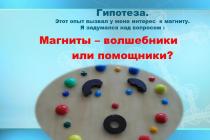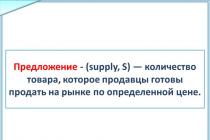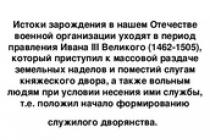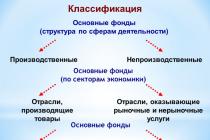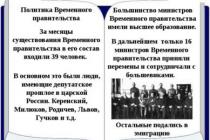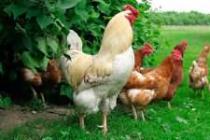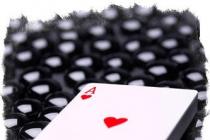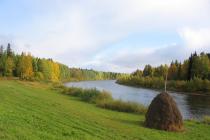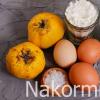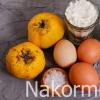
My research. I decided to use experiments to find out the useful properties of a magnet. And also find out: Who invented the magnet? What do adults use it for? How can children use it? I set myself the following goal and objectives: Goal: To find out the useful properties of a magnet. Objectives: Find out who invented the magnet, what adults use it for, how children can use it.






Step three: To make sure of the properties of a magnet, I conducted a practical experiment: “Will it attract or not?” and concluded: Some metallic objects are attracted to a magnet, but non-metallic objects do not experience its attraction. (There are metal and non-metal objects on the table)

Step four: The experiment was so interesting that I decided to create games - experiments and play them with friends. So, playing games - experiments “Find a needle in a haystack”, “Help Cinderella”, I, together with my friends, became convinced once again that a magnet attracts iron objects. (There are rice grains and small iron nuts on the tray)



And the games - experiments: “Cat and Mice”, “Merry Guys”, “Once Upon a Time There Were Smeshariki”, convinced us that magnets act through chipboard, plywood, thin boards, cardboard. (At the bottom of the cone mice, a cat, funny guys, metal plates are glued, and Smeshariki are glued to bolts)


Taking advantage of the magical effect of a magnet on metal, I learned how to create interesting pictures and learned what a magnetic field is. “Thawed patches” “Cheerful hedgehog” “Winter is coming” “Dust storm” Remember - allowing children to manipulate sawdust on their own is dangerous. (It is best to use a box with transparent plastic on top and bottom for this, place sawdust there, carefully seal the edges with tape, and attach the design to the bottom).



The story “Magnet is a Helper” And one day, such an incident happened. My grandmother is old and sick, and therefore my mother often goes to visit her. She helps her cook, clean, do laundry, and take care of pets and birds. And so, after all the work, they decided to relax, took a family album, and sat on the sofa. Grandma began to put on her glasses and suddenly the darling flew away. As it turned out, a small bolt had become unscrewed and had also rolled somewhere. Knowing my passion for magnets, my mother urgently called me by phone. I arrived and easily found the bolt using my magic magnet.




While collecting magnets, I learned a new word “memomagnetism”. Do you know what it means? This is what people now call the hobby of collecting magnets. The record for the number of collected magnets belongs to the American Louise Greenfarb from Henderson (a suburb of Las Vegas, Nevada). Her record is thousands of magnets.
 Now I know for sure that magnets are both wizards and helpers!!! All games and experiments are very simple and do not need description; you just have to look at the photographs and you can easily guess how to carry them out. Try playing such experimental games with your children, and you will see for yourself that it is very interesting, exciting and educational!
Now I know for sure that magnets are both wizards and helpers!!! All games and experiments are very simple and do not need description; you just have to look at the photographs and you can easily guess how to carry them out. Try playing such experimental games with your children, and you will see for yourself that it is very interesting, exciting and educational!

Thank you for your attention! Compensating group Municipal budgetary preschool educational institution combined type kindergarten 39 of the municipal formation Ust-Labinsky district, Krasnodar region Pupil: Danil Gnatusha Head: teacher Poddubnaya N.I.

Presentation on the topic "The Magical World of Magnetism" in physics in powerpoint format. The purpose of this presentation for schoolchildren is to expand students' knowledge about the magnetic field. From this work, students will learn how magnets were discovered, why they are called that, where they are used, as well as what the Earth’s magnetic field is and whether other planets have magnetic fields. Author of the presentation: Lyudmila Aleksandrovna Shkolkina, physics teacher.

Fragments from the presentation
How did people learn about magnets and why were they called that?
- “This stone not only attracts the iron ring, but also imparts its power to this ring, so that it in turn can attract another ring or piece of iron. This happens due to the power of the magnetic stone.” This is what the ancient Greek philosopher Socrates wrote.
- An ancient chronicle tells that 4000 years ago in China, carts were used, on which magnetic figures of a person turned on an axis, pointing with his hand to the south
- In Chinese encyclopedias there are also the first mentions of the use of a magnetic needle on ships. 300-400 BC, Indians, Arabs, and Greeks began to use it. This is how a compass appeared in ancient times, which became a reliable assistant for travelers.
- “Loving stone”, the Chinese gave the name to the magnet; it attracts iron, like a loving mother attracts her children to herself. It is remarkable that the French, living on the opposite end of the continent, also encounter a similar name “animant” - which means “loving”. The power of love in natural magnets is insignificant, so the Greek name “Hercules stone” sounds naive. What would they say now in comparison with electromagnets lifting tons of iron in metallurgical plants?
Why is the earth surrounded by a magnetic field?
- Earth's magnetism is not yet fully understood, but it is read that a magnetic field creates an electric current. Arising, as in the Earth’s crust, in the atmosphere, and especially in the Earth’s core, where charged particles move in a hot state. The strongest magnetic field at the poles, their names north and south are opposite to the names of the geographical poles. After all, the north end of the magnetic needle is always directed south , which means the south magnetic pole is in the north. In addition, their coordinates do not coincide with geographical ones.
- Over time, the magnetic poles move. In ancient times they were located at the equator.
- The magnetic field depends on the activity of the suns. And during the period of its activity, magnetic storms arise on the earth, the northern lights intensify, which arise as a result of the influence of the magnetic field on incoming charged particles. The magnetic field protects the earth from cosmic radiation, which has a detrimental effect on living organisms. In areas where there are deposits of magnetic ores, the magnetic field is different from other places - this is called magnetic anomalies, where the magnetic needle is not an assistant. The Earth is surrounded by radiation belts, so in the direction of the sun they extend to a distance of 70-80 thousand kilometers. And in the opposite direction, up to millions of kilometers.
Earth's magnetic field
- English physicist of the 14th century. William Herbert made a spherical magnet, examined it with a small magnetic needle and came to the conclusion that the globe was a huge cosmic magnet.
- The outer, molten layers of the Earth's core are in constant motion. As a result, magnetic fields arise in it, ultimately forming the Earth's magnetic field.
Magnetic anomalies
- Anomaly (lat.) – deviation.
- A short-term anomaly is a magnetic storm.
- Constant anomalies are deposits of iron ore at shallow depths.
Where are magnets used?
- (devices are different magnets. Magnetic needles, measuring instruments, loudspeaker, tape, coil cores)
- Hard drives record data on thin magnetic coatings.
- Modern technology cannot do without the use of magnets - these are measuring instruments - ammeters, voltmeters, electric meters, loudspeakers; cores for engines, generators, transformers, tapes are made from magnetic materials, magnetic recording of sound is carried out, huge weights are lifted in factories, there are even trains on a magnetic cushion. It is impossible to imagine technology without magnets and electromagnets.
In World of Health stores I saw many products containing magnets, why and how do they affect a person?
- First use of a magnet - laxative
- Scientific research shows that the human body contains iron, water molecules and other substances that respond well to changes in the magnetic field, and if any disturbances occur, the influence of the magnetic field can restore or delay these changes. It depends on the nervous state, health, even gender of the person. Magnetic devices such as magnetic bracelets, belts, insoles, funnels, clips, combs reduce pain and reduce blood pressure. Fatigue and much more. Unlike medicines, they are durable, cannot be counterfeited, can be used by the whole family, and are inexpensive.
Magnetic bracelets
The healing properties of the magnetic field were discovered by mankind in ancient times. Women of Ancient Egypt wore magnetic jewelry, believing that it could protect them from disease and prolong youth.
Magneto therapy
Magnetic healing belt for the back
Is it only our Earth that is surrounded by a magnetic field?
Of course, during the flights of spacecraft, scientists were also interested in the presence of magnetic fields on other planets. The closest celestial body to us is the Moon, it has no magnetic field, like Earth’s sister Venus, a weak magnetic field and Mars, but the giant planets have very strong magnetic fields - Jupiter, Saturn, Neptune
Conclusion
- Today, guys, with the help of high school students, you got acquainted with the wonderful world of magnets, you knew about them before, but now you realized that your knowledge has become deeper, in high school you will study the magnetic field and its application in even more detail
- All participants receive excellent marks for their presentations and intelligent questions.
MUNICIPAL BUDGET PRESCHOOL
EDUCATIONAL INSTITUTION KINDERGARTEN No. 2
city of BELORECHENSK
MUNICIPAL FORMATION BELORECHENSKY DISTRICT
Summary of direct educational activities
with children of the senior group on cognitive activity:
"All the secrets of the magnet"
Performed:
Educator
Mavrina L.Yu
year 2014
Educational field: cognitive
Type of activity: direct educational
Age group: senior
Topic: “Mysterious magnet.”
Goal: Creating conditions for the formation of the basic holistic worldview of a child of senior preschool age by means of a physical experiment.
Program content.
Educational objectives: To form ideas about a magnet and its property of attracting objects. Continue to teach independently, make decisions during experimental activities; check these decisions; draw conclusions from the results of this test, learn to make generalizations.
Developmental: To develop the child’s cognitive activity in the process of getting to know the hidden properties of a magnet, curiosity, the desire for independent knowledge and reflection, logical thinking. Develop communication skills.
Educational: Cultivate friendly relationships, the desire to come to the aid of others.
Cultivate accuracy in work.
Preliminary work: Games with a magnetic board and magnetic letters; examination of different types of magnets; games with a magnet in the experimentation corner “Fishing”, “Butterfly”; research activity at home “What attracts a magnet?”
Vocabulary work: Activate vocabulary on the topic: magnetism, magnetic and non-magnetic objects, attraction, magnetic force, magnetite.
Materials and equipment: iron, plastic objects, pieces of fabric, paper, foam; magnets, metal keys, trays for handouts, paper animal figures,
Guys, today I invite you to become real researchers and conduct real experiments in a real laboratory!
Educator:
All the children gathered in a circle
You are my friend and I am your friend
Let's hold hands together and smile at each other
Educator: Look, a box has appeared on our table. And there is something lying there. Go up and take the item from this box. Who knows what it is?
Children: Magnet.
Educator: You all know this stone
Educator: Here in front of you is an ordinary magnet,
He keeps many secrets within himself.
Educator: look in our box there is something else...
(I take out the mitten in which the magnet is hidden and put it on my hand).
I have a mitten
With her I’m just a master.
Take a closer look,
Watch my hand
(I show a plate with beans and metal objects).
Using my “magic mitt,” I quickly sort through the beans (I cover the contents of the plate with the mitt, metal objects are magnetized to the mitt, and the beans remain in the plate).
Try to unravel this magic? (children's answers)
And I can tell you, these objects are magnetized.
Guys, do you want to know what secrets a magnet holds and why it is called that? Then I invite you to the cinema to watch a film about a magnet.
2. View the presentation “Magic Magnet”
1. slide Teacher. I'll tell you an old legend. In ancient times it was said that far, far away at the edge of the world there was a huge Mount Ida. One day an old man named Magnis wandered past this mountain. He noticed that his iron-lined sandals and a wooden stick with an iron tip were sticking to the black stones that lay in abundance under his feet. Magnis turned the stick over with the tip up and made sure that the tree was not attracted to strange stones. I took off my sandals and saw that my bare feet weren’t attracted to me either.
Magnis realized that these strange black stones did not recognize any other materials except iron. Since then, this unusual stone began to be called by the old man’s name “Magnus stone” or simply a magnet. This is how the name “magnet” appeared.
There is another explanation for the word magnet - after the name of the ancient city of Magnesia, where these stones were found by the ancient Greeks. Now this area is called Manisa, and magnets are still found there.
2.slide A stone is a magnet that has the property of attracting iron.
3.slide Scientists have come up with special machines for processing this stone and producing a magnet. People learned to make magnets themselves by magnetizing pieces of iron.
4. slide Magnets attract metal objects - this is called magnetism, and objects that are attracted to a magnet are called magnetic.
5. slide There are a huge number of different types of magnets
6. slide These are large magnets. They are used to lift very large quantities of iron, as well as in the construction of underwater structures (for securing tools under water).
7.slide Magnets are used in the production of diesel locomotives, high-speed trains, airplanes, electric saws, drills, and for instruments in cars and airplanes.
8.slide People make jewelry from magnets: earrings, bracelets, rings, beads. They even believe that they have healing properties, calm and give strength.
9. slide Magnets are also used to make toys and games for children and adults.
10. slide Cartoons are made about magnets.
Educator: Guys, why was the magnet called that?
Where is it used?
What secret does a magnet keep?
3. Experimental activities of children.
Educator: Guys, now I invite you to become little researchers. Who are the researchers? (this is a person who studies something). Researchers begin their work with experiments and experiments. And you and I will also experiment and study the properties of magnets. Wear aprons and caps and enter our laboratory.
If a magnet is so strong and attracts iron objects, then maybe it should also attract other objects? To check this, I suggest you experiment:
“An experiment is an important thing! Every moment of it is interesting to us.”
We will conduct an experiment and find out whether everything is attracted by a magnet? The magic begins!
Guys, let's see what wonderful properties our magic stone - a magnet - has. To do this, you need to bring a magnet to each of your items.
- put all the objects that the magnet attracts into a white tray;
- Place items in the yellow tray that do not respond to the magnet.
4. Independent work.
Experience No. 1
Get started! Tell us what you did and what worked out for you.
Children: I passed a magnet over objects and all iron objects were attracted to it. This means that the magnet attracts iron objects (iron scrapers, screws, nuts).
Educator: What objects did the magnet not attract? (plastic button, piece of fabric, wooden pencil, eraser)
Experience No. 2
Place: Now place a sheet of paper on the iron objects and bring a magnet to it. What happened?
Children: Iron objects were magnetized through paper. The magnet acts through the paper.
Experience No. 3
Educator: Now cover the iron objects with a piece of cloth and bring a magnet. Show what happened.
Children: The magnet acts through the fabric. (Iron objects are magnetized through the fabric).
Experience No. 4
Educator: Place all the iron objects on a plastic tray, and pass the magnet under the tray. What's happening?
Children: Objects move. The magnet operates through a thin plastic tray.
Conclusion: A magnet only attracts iron objects.
The magnet acts through paper, fabric, or a thin plastic tray.
Experience No. 5
Educator: The next trick is to arrange a “Disco for the animals”
You need to put the silhouette of an animal (picture) in a cardboard box and place a magnet on the bent part. With the second magnet we make various movements under the box. (to music)
Children: The magnet acts through the cardboard.
Educator: Magnets can act through paper, so they are used, for example, to attach notes to the metal door of a refrigerator.
Physical education minute
Making scientific discoveries is not an easy task, so there are rest breaks in laboratories. It would be nice for us to rest a little. And now everyone got up together, everyone came out to me in a circle, we begin our vigorous exercises in order
St. John's "One, two, three, repeat..."
Educator: Let's continue our journey
Experience No. 7
Guys, look at the glasses of water in front of us, what's at the bottom? Keys
Now let's think about how you can get the key out of the glass without getting your hands wet?
Children's answers. independent activity
5. Reflection.
Educator:
What new did you learn about magnets today?
Children: A magnet attracts iron objects, acts through paper, fabric, glass, cardboard, water, magnets attract each other, a magnet acts at a distance.
Educator: Guys, where in our group can you meet a magnet and see its magical properties? (in wardrobes, magnetic letters, holders, magnetic game..)
Educator: Knowing the properties of a magnet, you can come up with interesting games to play. I invite you to the gaming room. I have prepared Magneticus magnetic kits for you, where you can once again see the properties of a magnet.
Municipal preschool educational institution No. 8 “Lenok” of the Yaroslavl municipal district
Abstract of GCD
« Magic magnet"
Preparatory group
Prepared by the teacher:
Tyurina I. V.
January 2017
Target:
Introduce children to the properties of a magnet.
Educational objectives:
- help children accumulate specific ideas about a magnet and its ability to attract objects; identify materials that can become magnetic, through which materials and substances a magnet can act;
Developmental tasks:
-develop mental operations, the ability to draw conclusions, activate children’s vocabulary;
- develop the desire for knowledge through creative and experimental activities;
Educational tasks:
- promote the development of independence, initiative, and the development of communication skills;
Material:
Magnets, plates with objects: rubber ball, button, paper clip, match, sheet of paper, fabric; cups of water, plastic boards, plates with millet.
Magic Magnet.
Progress of the lesson:
Organizational moment, emotional mood:
All the children gathered in a circle,
You are my friend and I am your friend!
Let's hold hands together
And let's smile at each other!
(Point of surprise, problematic situation):
- Guys, I know that you love fairy tales. I also love fairy tales, they always have magic and mystery. In fairy tales, good always triumphs over evil. Do you agree? Would you like to help fairy-tale characters if they turned to you for help? Today you will have such an opportunity.
Presentation
Slide 2. Ivan Tsarevich
Experience No. 1 “The action of a magnet through water and obstacles”
This hero came to us with a request. Who is this? Think about what could have happened to him for him to turn to us for help?(children's reasoning)
Guys, the evil Koschey the Immortal hid a treasure sword at the bottom of a deep well. Without this sword, Ivan will not be able to save his bride Vasilisa the Beautiful from captivity. He doesn't know how to get it. Let's figure out how to help Ivan(children talk)
You proposed very interesting ideas. Guys, maybe you can get a sword using a magnet? Let's try.
The main rules in our laboratory: do not push, do not make noise, do not disturb others, do everything calmly. This is exactly how scientists perform experiments in their laboratories.
Place a paper clip in a glass of water - this is an axe. Using a magnet, we pull out a paper clip - an ax - along the outer wall of the glass. Happened?
- What conclusion can be drawn?
Conclusion: the force of a magnet acts through water and through an obstacle.
Look at the screen. Now Ivan Tsarevich will be able to get his sword from the well and save Vasilisa the Beautiful.
Slide 3. Alice in the room.
Experience No. 2 "The action of a magnet through an obstacle"
The girl Alice really wants to get to Wonderland - to a beautiful blooming garden. This little door leads there. But the key to the door lies on a high plastic table. How can she get it?(children talk)
- A magnet helped Ivan Tsarevich. Maybe he can help us now. Let's try?
- Let's put the paperclip on a plastic board and move the magnet under the board. The force of the magnet passing through the plastic forces the paperclip to follow it. Happened? This means that the magnetic force acts through the plastic.
Conclusion: the force of a magnet acts through an obstacle.
Look at the screen. With the help of a magnet, Alice got the key.
Slide 4. Alice in the garden.
Alice was able to get into the magical garden of Wonderland.
Slide 5. Cinderella sits in front of the millet.
Experience No. 3 “The action of a magnet through millet (cereals, sand)”
Cinderella really wants to go to the ball. But the evil stepmother and mischievous sisters poured iron bolts into her millet, hoping that the poor thing would not make it in time. How can I help her?(children talk)
Maybe the magnet will help us again? Shall we try?
Children and a teacher conduct an experiment.
- We slowly pass a magnet over a plate with millet in which metal paper clips are hidden. What's happening? (paper clips are magnetized)
Using a magnet, we were able to assemble the scrapers easier and faster. You and I have experimentally proven that magnetic forces act through millet.
Conclusion: the force of the magnet acts through the millet.
Look at the screen. Cinderella was able to quickly sort out the millet and was in time for the ball
Slide 6. Cinderella at the ball.
I think it's time for you and me to relax and dance
Slide 7. Physical exercise “Repeat! Do not snooze!"
We had a great time and had a lot of fun. Meanwhile, I received an email from another fairy-tale hero.
Slide 8. A letter arrived
Listen.
Slide 9.Text of the letter.
"Dear Guys! I decided to go visit Vintik and Shpuntik. But here's the problem - my car broke down. To repair it, you only need metal parts. Which ones are metal and which ones are not, I don’t know. What should I do?"
Who wrote us such a letter?(children's answers)
Slide 10. Dunno with a car.
That's right, Dunno. How can we help him?(children talk)
Experience No. 4 “A magnet attracts only metal parts”
Slide 11. Dunno with different details.
– How can we distinguish metal parts from others? (To do this correctly, you need to use a magnet).
–What do we know about the properties of a magnet? (A magnet has the property of attracting iron objects to itself.) How can these properties be checked? (Take a magnet and conduct an experiment).
Children and their teacher go to the laboratory.
There are many objects made of different materials (magnetic and non-magnetic) on the tables. You need to select only metal ones. We will enter the results obtained into a table.
Children do the experiment on their own.
– And now we will enter the results of the experiment into the table using the signs “+” and “-”.
Working with a table.
– What objects are attracted by a magnet?
Conclusion: A magnet attracts iron objects, so to separate them from the rest, you need to use a magnet.
But a magnet only attracts certain metals, such as iron, steel and nickel. Other metals, such as aluminum, are not attracted to the magnet. Wood, plastic, paper, fabric do not react to magnets.
- Guys, do you want to know how a person became acquainted with the magical properties of a magnet? I'll tell you an old legend.
Slide 12. Magnis with sheep.
In ancient times, on Mount Ida, a shepherd named Magnis tended sheep.
Slide 13. Magnis with a stone.
He noticed that his iron-lined sandals and a wooden stick with an iron tip were sticking to the black stones that lay in abundance under his feet.
Slide 14. Magnis with a stick.
The shepherd turned the stick upside down and made sure that the tree was not attracted by strange stones.
Slide 15. Magnis takes off his shoes.
I took off my sandals and saw that my bare feet weren’t attracted to me either.
Slide 16. Stones in hand.
Magnis realized that these strange black stones did not recognize any other materials except iron.
Slide 17. Magnis with his neighbors.
The shepherd took several of these stones home and amazed his neighbors.
Slide 18. Magnet with a piece of iron.
The name “magnet” came from the name of the shepherd.
This is how people learned about the magnet and began to use it used in the production of diesel locomotives, trains, airplanes(slide 19-20) , they also make jewelry from magnets: earrings, bracelets, rings, beads(slide 21) . They even believe that they have healing properties, calm and give strength.(slide 22-23) .
Guys, today we learned a lot and helped fairy-tale characters. But they forgot something(children remember that they forgot - tell Dunno how to distinguish metallic from non-metallic parts)
Slide 24. Dunno with a car.
- How can we tell Dunno about this? (Children's suggestions).
Yes, we will write a letter to Dunno, send him our table and magnet. Dunno will definitely repair his car and go to visit his friends.
Guys, look at our magnetic board.
(There are 2 pictures on the board: a sunny day and a rainy day)
If you were interested today, you had a good time and learned a lot of new things, then attach your magnet to the picture with a sunny day. If it was boring, uninteresting, then go to a picture with a rainy day.
Software tasks. Introduce children to a magnet and its properties (attract iron objects, attract through obstacles). Form speech and cognitive activity in the process of conducting experiments.
Equipment: magnets, objects made of different materials (glass, plastic, wood, rubber, iron), research cards for each child.
Teacher:“Today we will meet with our old acquaintance. Do you recognize him? (Slide 2) This is the story that happened to him. Dunno found a stone on the road. (Slide 3) He put it in his pocket and went home. But passing by the houses of his friends, Dunno realized that something strange was happening. Pots, spoons, knives, ladles, nails and other metal objects seemed to come to life and attacked him from all sides. “Have I really found a magic stone that makes everything move?” - thought Dunno. Let's try to figure out together what's going on here. Here is the stone that Dunno found. (Slide 4) Yes, indeed, this is not an ordinary stone. This is a real magnet. And it has a magnetic force that attracts many objects. The ancient Greeks found it more than two thousand years ago. It was named after the ancient Turkish city of Magnesia. Let us find out today whether all materials are attracted by a magnet.”
Experiment “Is everything attracted by a magnet?”
Teacher:“What materials do you see on the table? (Items made of wood, iron, plastic, paper, fabric, rubber)”
Children take one object at a time, name the material and bring a magnet to it. The conclusion is drawn that iron objects are attracted, but non-iron objects are not. The results are recorded in the research card.
(Slide 5) Game “What will be attracted to a magnet?”
Teacher:“Name the objects that will be attracted to a magnet. Why? “The pencil won’t be attracted to the magnet because it’s made of wood.”
Experiment “Does a magnet act through other materials?”
For the experiment you will need a magnet, a glass jug of water, and paper clips. Throw a paper clip into a jug of water. We lean the magnet against the jug at the level of the paperclip. After the paperclip approaches the wall of the jug, slowly move the magnet upward along the wall.
Teacher:“What do we see? The paperclip follows the movement of the magnet and rises upward until it approaches the surface of the water. Can a magnet attract through obstacles? (The magnet can work through glass and water.)”
Teacher:“Can a magnet act through a wooden table or a plastic partition?” Children carry out the experiment independently and come to the conclusion: “A magnet can attract through a wooden table, through plastic.”
Teacher:“Dunno liked playing with the magnet. He even came up with a magnetic machine.” The teacher shows a toy car with a magnet attached. “When Dunno brought the magnet to the car. The car moved forward. (Demonstration by teacher)
But one day, the car began to move in the other direction. (Demonstration by the teacher)) “The magnet is broken,” Dunno decided and was very upset. Why is this happening. It turns out that a magnet has different poles. When we bring identical poles together, the car moves away. When we bring different ones together, a car drives up. Now I’ll bring the magnet to the machine, and you guessed it – they were different or the same poles. Immediately mark the sides of the magnets with colored paper.
The outdoor game “Magnets” is being played ”
Teacher:“And now each of you will turn into a magnet with two poles”
Children put cardboard gloves of different colors on their hands - blue on the left, red on the right. They scatter in different directions. At the signal “The magnets are attracted,” the children must join hands: blue palms for red ones and vice versa.
Game “Cars”
Teacher:“In which direction will the cars go if the magnets are directed at each other with different poles (slide 6), identical poles (slide 7)? Why?"
Working with handouts
Teacher:“Now you will determine the poles of your magnets yourself. Bring the magnets close to each other. If they attract, then these are different poles. Stick different colored paper on them.
Children independently determine the poles of their small magnets by sticking self-adhesive paper. (This task can be difficult for children, so the teacher’s help is very important)
Teacher:“Where are magnets used?” (Slides 8-15)
Summing up the lesson(slide 16)
Teacher:“What did we learn new about magnets today? (A magnet has different poles. It attracts iron objects. It can attract through others.)

